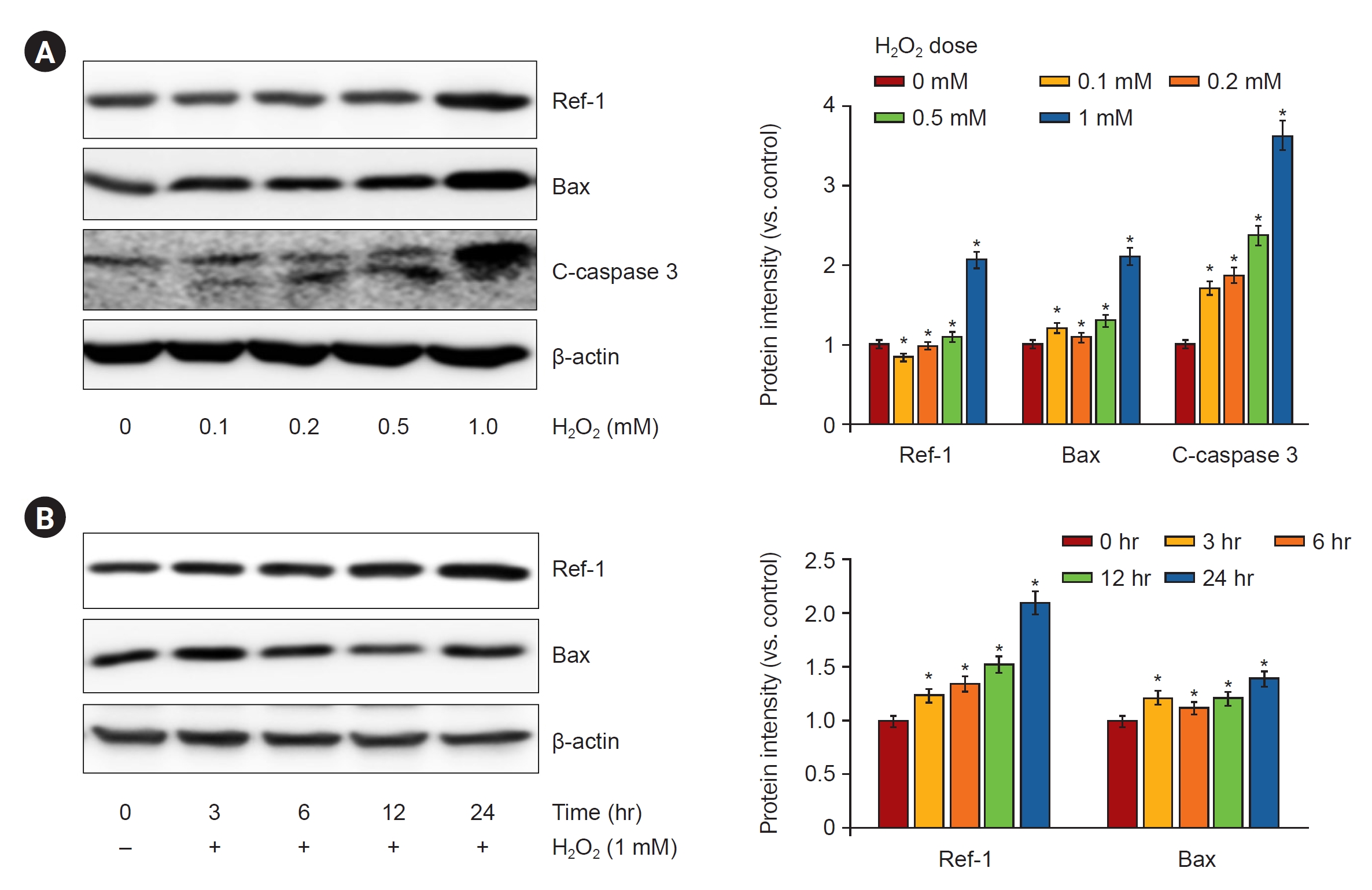1. Collins T, Read MA, Neish AS, Whitley MZ, Thanos D, Maniatis T. Transcriptional regulation of endothelial cell adhesion molecules: NF-kappa B and cytokine-inducible enhancers.
FASEB J 1995;9:899–909.



3. Bennett RA, Wilson DM 3rd, Wong D, Demple B. Interaction of human apurinic endonuclease and DNA polymerase beta in the base excision repair pathway.
Proc Natl Acad Sci U S A 1997;94:7166–7169.


4. Tell G, Damante G, Caldwell D, Kelley MR. The intracellular localization of APE1/Ref-1: more than a passive phenomenon?
Antioxid Redox Signal 2005;7:367–384.


5. Chattopadhyay R, Wiederhold L, Szczesny B, et al. Identification and characterization of mitochondrial abasic (AP)-endonuclease in mammalian cells.
Nucleic Acids Res 2006;34:2067–2076.



6. Jackson EB, Theriot CA, Chattopadhyay R, Mitra S, Izumi T. Analysis of nuclear transport signals in the human apurinic/apyrimidinic endonuclease (APE1/Ref1).
Nucleic Acids Res 2005;33:3303–3312.



7. Qu J, Liu GH, Huang B, Chen C. Nitric oxide controls nuclear export of APE1/Ref-1 through S-nitrosation of cysteines 93 and 310.
Nucleic Acids Res 2007;35:2522–2532.



10. Sengupta S, Mitra S, Bhakat KK. Dual regulatory roles of human AP-endonuclease (APE1/Ref-1) in CDKN1A/p21 expression.
PLoS One 2013;8:e68467.



11. Xanthoudakis S, Miao GG, Curran T. The redox and DNA-repair activities of Ref-1 are encoded by nonoverlapping domains.
Proc Natl Acad Sci U S A 1994;91:23–27.



12. Kakolyris S, Kaklamanis L, Giatromanolaki A, et al. Expression and subcellular localization of human AP endonuclease 1 (HAP1/Ref-1) protein: a basis for its role in human disease.
Histopathology 1998;33:561–569.



13. Barnham KJ, Masters CL, Bush AI. Neurodegenerative diseases and oxidative stress.
Nat Rev Drug Discov 2004;3:205–214.



15. Thomson BG, Tritt R, Davis M, Perlman EJ, Kelley MR. Apurinic/apyrimidinic endonuclease expression in pediatric yolk sac tumors.
Anticancer Res 2000;20(6B):4153–4157.

16. Stetler RA, Gao Y, Leak RK, et al. APE1/Ref-1 facilitates recovery of gray and white matter and neurological function after mild stroke injury.
Proc Natl Acad Sci U S A 2016;113:E3558–E3567.



17. Evans AR, Limp-Foster M, Kelley MR. Going APE over ref-1.
Mutat Res 2000;461:83–108.


18. Yoo DG, Song YJ, Cho EJ, et al. Alteration of APE1/ref-1 expression in non-small cell lung cancer: the implications of impaired extracellular superoxide dismutase and catalase antioxidant systems.
Lung Cancer 2008;60:277–284.


19. Grösch S, Fritz G, Kaina B. Apurinic endonuclease (Ref-1) is induced in mammalian cells by oxidative stress and involved in clastogenic adaptation.
Cancer Res 1998;58:4410–4416.

21. Nishi T, Shimizu N, Hiramoto M, et al. Spatial redox regulation of a critical cysteine residue of NF-kappa B in vivo.
J Biol Chem 2002;277:44548–44556.

22. Cesaratto L, Calligaris SD, Vascotto C, et al. Bilirubin-induced cell toxicity involves PTEN activation through an APE1/Ref-1-dependent pathway.
J Mol Med (Berl) 2007;85:1099–1112.



23. Nakshatri H, Bhat-Nakshatri P, Currie RA. Subunit association and DNA binding activity of the heterotrimeric transcription factor NF-Y is regulated by cellular redox.
J Biol Chem 1996;271:28784–28791.


24. Huang LE, Arany Z, Livingston DM, Bunn HF. Activation of hypoxia-inducible transcription factor depends primarily upon redox-sensitive stabilization of its alpha subunit.
J Biol Chem 1996;271:32253–32259.

26. Gaiddon C, Moorthy NC, Prives C. Ref-1 regulates the transactivation and pro-apoptotic functions of p53 in vivo.
EMBO J 1999;18:5609–5621.



27. Fan Z, Beresford PJ, Zhang D, et al. Cleaving the oxidative repair protein Ape1 enhances cell death mediated by granzyme A.
Nat Immunol 2003;4:145–153.



28. Lee YR, Kim KM, Jeon BH, Choi S. Extracellularly secreted APE1/Ref-1 triggers apoptosis in triple-negative breast cancer cells via RAGE binding, which is mediated through acetylation.
Oncotarget 2015;6:23383–23398.



29. Pines A, Bivi N, Romanello M, et al. Cross-regulation between Egr-1 and APE/Ref-1 during early response to oxidative stress in the human osteoblastic HOBIT cell line: evidence for an autoregulatory loop.
Free Radic Res 2005;39:269–281.


30. Pines A, Perrone L, Bivi N, et al. Activation of APE1/Ref-1 is dependent on reactive oxygen species generated after purinergic receptor stimulation by ATP.
Nucleic Acids Res 2005;33:4379–4394.



31. Chang L, Karin M. Mammalian MAP kinase signalling cascades.
Nature 2001;410:37–40.



32. Davis RJ. Signal transduction by the JNK group of MAP kinases.
Cell 2000;103:239–252.


33. Johnson GL, Lapadat R. Mitogen-activated protein kinase pathways mediated by ERK, JNK, and p38 protein kinases.
Science 2002;298:1911–1912.


34. Montaldi AP, Godoy PR, Sakamoto-Hojo ET. APE1/REF-1 down-regulation enhances the cytotoxic effects of temozolomide in a resistant glioblastoma cell line.
Mutat Res Genet Toxicol Environ Mutagen 2015;793:19–29.


35. Hong J, Chen Z, Peng D, et al. APE1-mediated DNA damage repair provides survival advantage for esophageal adenocarcinoma cells in response to acidic bile salts.
Oncotarget 2016;7:16688–16702.



36. Lin A, Karin M. NF-kappaB in cancer: a marked target.
Semin Cancer Biol 2003;13:107–114.

37. Yamamoto Y, Gaynor RB. Role of the NF-kappaB pathway in the pathogenesis of human disease states.
Curr Mol Med 2001;1:287–296.

38. Lipton SA. Janus faces of NF-kappa B: neurodestruction versus neuroprotection.
Nat Med 1997;3:20–22.



39. Manna SK, Mukhopadhyay A, Aggarwal BB. Resveratrol suppresses TNF-induced activation of nuclear transcription factors NF-kappa B, activator protein-1, and apoptosis: potential role of reactive oxygen intermediates and lipid peroxidation.
J Immunol 2000;164:6509–6519.

40. Beg AA, Baldwin AS Jr. The I kappa B proteins: multifunctional regulators of Rel/NF-kappa B transcription factors.
Genes Dev 1993;7:2064–2070.
























 PDF Links
PDF Links PubReader
PubReader ePub Link
ePub Link Full text via DOI
Full text via DOI Download Citation
Download Citation Print
Print















